Tuling around for California bass
Working the vast stands of tules yields abundant largemouth action
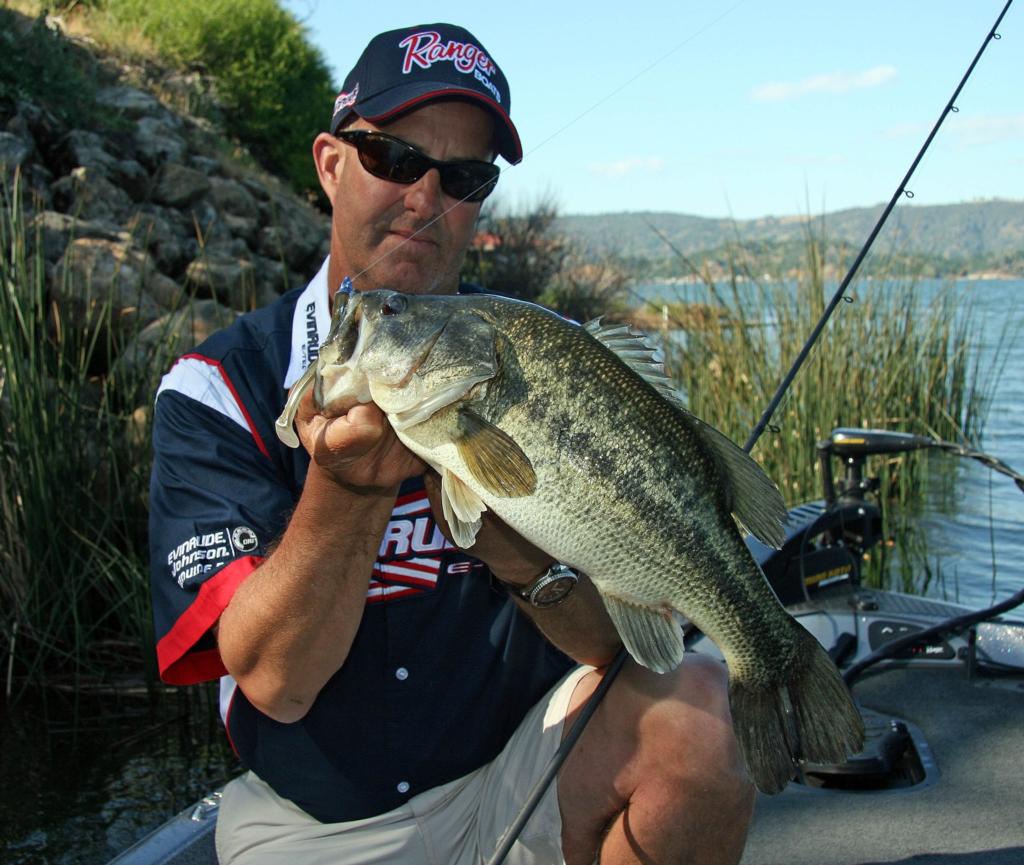
Lake Okeechobee has its Kissimmee grass, Southern Louisiana marshes sprout Roseau cane. In northern California, the vegetation of preference sounds more like street slang than prime bass habitat.
Distinctly simplistic but steeped in that relaxed California vibe, the name tule (pronounced “too-lee”) rolls casually off the tongue, rings comfortably in the ear and conjures visions of rod-bending action for those who’ve fished the tall, thin stalks.
From Clear Lake to the Delta region, tules are both the go-to and the fall-back options when largemouth bass top the target list. Spawning season sees waves of giants invading this shallow vegetation, but a variety of reaction baits and finesse tactics tempt lunkers throughout most of the year.
The tule advantage
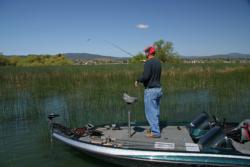 Proximity and accessibility – tules have these significant logistical points in their favor. The marshy structure is easy to reach – often just a short run from launch sites – and tules won’t keep you bouncing in rough, open water during windy days. Moreover, where you find tules, you find a lot of tules, so several boats can work the same area with room for all.
Proximity and accessibility – tules have these significant logistical points in their favor. The marshy structure is easy to reach – often just a short run from launch sites – and tules won’t keep you bouncing in rough, open water during windy days. Moreover, where you find tules, you find a lot of tules, so several boats can work the same area with room for all.
Bass like tules because the densely growing aquatic plants form labyrinthine habitat with plenty of shelter and ambush points. Forage sources such as crawdads, bluegills, silverside minnows and (seasonally) bass fry keep the chow line running.
From Clear Lake’s sprawling fields of swaying shoreline stalks to the Delta’s high “tule berms,” the predictably random composition stands ever diverse. For optimal coverage, narrow your search by seeking the sweet spots where bass can hunker down and wait for food. Breaks in tule lines funnel current and create natural feeding stations, while tules flanking the mouths of creeks and sloughs offer slam-dunk potential.
Scott Green runs the Marine Unlimited Ranger dealership in Santa Rosa, Calif., and fishes throughout tule range. He looks for recurring patterns within the vegetation.
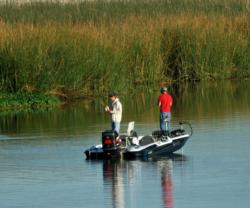 “I like to look at the tules as a lake with points, secondary points, mouths of creeks, etc.,” Green said. “(For example,) if you pattern the bigger fish in pockets off the secondary, sparse tule points, you can pretty much use that same pattern in most of the tule areas. The miles of tules are intimidating, but if you break it down like that, you can save a lot of time by eliminating dead water or staying in productive water.”
“I like to look at the tules as a lake with points, secondary points, mouths of creeks, etc.,” Green said. “(For example,) if you pattern the bigger fish in pockets off the secondary, sparse tule points, you can pretty much use that same pattern in most of the tule areas. The miles of tules are intimidating, but if you break it down like that, you can save a lot of time by eliminating dead water or staying in productive water.”
In the Delta, daily tide cycles raise and lower the water level, thereby moving fish to and from their preferred habitat. Timing one’s arrival to coincide with an incoming tide’s advancement into an attractive stand of tules often means intercepting legions of bass with feeding on their minds.
Tule tidbits
A large species of sedge in the Cyperaceae family, the tule has a thick, rounded green stem with long, grass-like leaves topped by clusters of light brown flowers. Growing to about 10 feet along creeks and 15 to 20 feet in marshlands, tules play an important ecological role by buffering shorelines from the full force of wind and waves. This allows other types of plants to take root and reduce erosion.
Of the 17 species of tules in California, the Common Tule (Schoeunoplectus acutus) is most abundant. The word “tule” comes from the indigenous Mexican word tullin (Nahuatl for “bulrush”), used by early settlers from New Spain who likened the marsh plants in California’s Central Valley to those in the marshes around Mexico City.
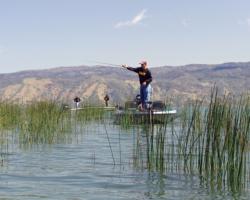 Notably, tules once lined the now-extinct Tulare Lake – formerly the largest freshwater body in the western United States. Located in the south end of the San Joaquin Valley, the lake was drained for land speculation during the early 20th century, but colloquial remembrance remains in the old Californian phrase “out in the tules,” which means “beyond far away.”
Notably, tules once lined the now-extinct Tulare Lake – formerly the largest freshwater body in the western United States. Located in the south end of the San Joaquin Valley, the lake was drained for land speculation during the early 20th century, but colloquial remembrance remains in the old Californian phrase “out in the tules,” which means “beyond far away.”
California’s American Indians harvested tules and fashioned shelters, boats, and mats for sleeping and sitting from the durable stalks. Grinding dried tules yielded flour, while various preparations of this plant held medicinal properties. Today, visitors to Anderson Marsh State Historic Park at the south end of Clear Lake can tour an authentic Pomo Indian village with handmade tule houses, while the annual tule boat-building workshops and team races are a local favorite at Big Valley Rancheria southwest of Clear Lake.
Productive patterns
During the spring spawning period, Brentwood, Calif., pro Dee Thomas – widely regarded as the pioneer of local flipping tactics – relentlessly probes the Delta’s tule edges with a jig. On Clear Lake, Green often hunts spawners by pitching a weightless Texas-rigged Senko into pockets within patches of sparse tules.
“Try to imagine where a bedding bass would be sitting,” Green advises. “Look for spots where a fish can feel protected but still ambush (prey). You let the Senko flutter to the bottom, twitch it a couple of times and then move to the next spot.”
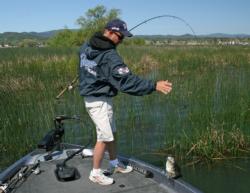 Slowing down a bit, shaky-head worms and drop-shots wiggled around the base of tule clumps can tighten your line in a hurry. Aaron Reitz of Soda Springs, Calif., who competes as a co-angler in Wal-Mart FLW Series and Stren Series events, is partial to the drop-shot. At any given moment, he’s most likely to be fishing his signature rig – a drop-shot sporting a 4-inch Roboworm in the Margarita Mutilator color. Appearance counts, he said, but it’s his meticulous technique that brings big bass to the back of the boat for him.
Slowing down a bit, shaky-head worms and drop-shots wiggled around the base of tule clumps can tighten your line in a hurry. Aaron Reitz of Soda Springs, Calif., who competes as a co-angler in Wal-Mart FLW Series and Stren Series events, is partial to the drop-shot. At any given moment, he’s most likely to be fishing his signature rig – a drop-shot sporting a 4-inch Roboworm in the Margarita Mutilator color. Appearance counts, he said, but it’s his meticulous technique that brings big bass to the back of the boat for him.
“I pick apart every tule clump I pass,” Reitz said. “I don’t just throw one time at a spot; I work every inch of it.”
Cranking clean lines of tules offers an effective way to find fish. Over grassy bottom, ChatterBait-like lures like the one that Coppertone pro Brett Hite used to win the FLW Series National Guard Western Division event in Oakley, Calif., handle the search duties without snagging.
Most any time of year, but especially during the spawn, California tules see lots of swimbaits. From modest soft plastics on leadheads or weighted wide-gap hooks to the full-bodied molded models up to a foot in length, long casts parallel to tule lines can take you straight to toad town.
Topwater plugs and buzzbaits will draw ferocious morning strikes, especially where current flows around tule points. As the sun rises, bass often retreat to the shady side of tule stands or duck under mats of wind-blown grass or hyacinth that stack against tules. This is prime time for a snag-proof frog. Just run the amphibian imposter over the surface vegetation and hang on to your rod.
When summer warms the skinny water, Green looks for bass around the deeper tule edges – those abutting rocks offer great promise. Jigs, Texas-rigged plastics and Carolina rigs deliver the deep bites in hot weather.